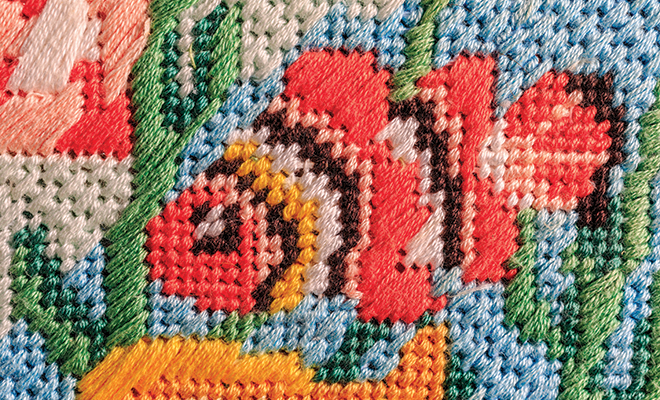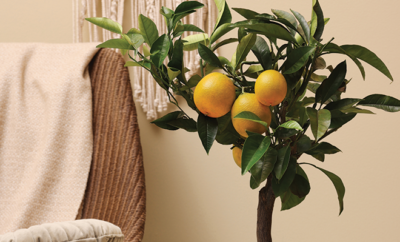
Needlepoint is Back!
A few years ago, both the Chicago Tribune and Washington Post predicted that needlepoint would be making a comeback as part of the trend for clothing and home furnishings with a homemade look. They pointed to interior designers such as Jonathan Adler and Trina Turk, who feature modern takes on traditional needlepoint pillows in their collections.
There’s nothing all that new about the craft of needlepoint. It dates to at least 1500 BCE, when it was practiced by the Egyptians. Also known as tapestry, needlepoint involves the creation of a picture with wool yarn on a stiff mesh canvas. The design is printed or painted onto the canvas and filled in with stitches in corresponding colors. Stitches entirely fill the canvas, creating a dense surface.
My own experience with needlepoint dates back to a full-page Ehrman Tapestry ad in one of my favorite craft magazines. I’d been a fan of the English company’s needlepoint kits for years. I decided to take the plunge in 2017 and purchased a pillow cover kit designed by Kaffee Fassett featuring a giant pink peony against a bright yellow background. Just looking at the design makes me happy.
I’ve completed a few counted cross stitch projects in the past, but there are some big differences between cross stitch and needlepoint. Cross stitch is done on soft fabric with an open weave. Two or more strands of cotton or silk thread are used to stitch a design on a portion of the fabric using stitches that look like an X. The design is followed from a paper chart, requiring you to constantly switch your attention between the chart and your stitches.
When my needlepoint kit arrived from Ehrman, it included a 20-square-inch printed canvas, yarn in a dozen colors, a tapestry needle, an instruction book and a printed chart of the design. The yarn was nicely sorted and precut into strands that are just the right length for stitching. I also purchased a wooden roller frame to keep the canvas taut and compact while I’m stitching.
Needlepoint isn’t difficult to master. I was able to read the instructions, set up my canvas and start stitching in a couple of hours. Advanced needlepointers use a variety of stitches on their canvases, but most kits only require you to use the basic diagonal stitch, also known as a tent or continental stitch. The instructions in my kit recommended using the printed design on the canvas as a guide and to only refer to the printed chart when the canvas design was unclear. I quickly found that not having to refer to the chart eliminated the constant attention switching required for counted cross stitch. I was free to stitch away.
The repetitive nature of needlepoint is one of the things that appeals to me most. Like knitting and crochet, needlepoint has relaxing and meditative qualities. The Craft Yarn Council describes needlework as “yoga for the brain” that calms the mind by focusing attention. It requires you to slow down, concentrate and quiet your thoughts. The relaxing state that needlework induces can help fight the negative effects of stress.
There are many sources for needlepoint canvases and supplies. The selection of designs range from cheeky sayings on monochrome backgrounds to facsimiles of medieval tapestries. You’ll find that needlepoint canvases and kits tend to be more expensive than some other types of craft materials because they are typically assembled by hand.
Needlepoint shops such as Aristeia Needlepoint in Santa Monica, California, typically feature handpainted or printed canvases and a selection of silk, wool and cotton yarns and threads. The advantage of brick-and-mortar shops is that they also offer needlepoint classes and are usually generous about providing advice and instruction. There are also a variety of online needlepoint retailers, including Elizabeth Bradley, Alice Peterson and The Needlepointer.
To save money on needlepoint, check out Etsy shops selling hand painted canvases at reasonable prices. General crafts retailers such as Herrschners, JoAnn and The Stitchery offer savings on needlepoint kits and supplies. Free needlepoint instructional videos are available on YouTube and Needlepoint.com. You can also save money by designing and painting your own canvases.
As for my needlepoint pillow, the most surprising part of the project has been the amount of time it requires to finish. After about 40 hours of stitching, only a quarter of my canvas is filled in. The nice thing about needlepoint is that it’s easy to pick up when you only have a few minutes for stitching, but it does require some commitment. It’s challenging for someone like me who likes to start new projects, but I know how satisfied I’ll feel when it’s finished and displayed in my home. ■
Sources: craftyarncouncil.com and www.ehrmantapestry.com.







